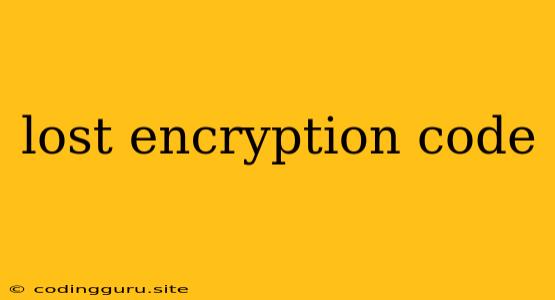Lost Encryption Code: A Guide to Recovery and Prevention
Losing your encryption code can be a frustrating and potentially disastrous situation, especially if you're dealing with sensitive data. This guide will help you understand why encryption codes are crucial, explore options for recovering a lost code, and offer valuable tips for preventing this issue in the future.
What is an Encryption Code?
Encryption codes, also known as encryption keys, are essential elements for securing digital information. They act like unique locks and keys, transforming plain text into an unreadable format known as ciphertext. To access the original data, you need the corresponding decryption code.
Why is Losing an Encryption Code a Problem?
Losing your encryption code effectively locks you out of your own data. Without the key, you can't decrypt the information, rendering it completely inaccessible. This can lead to:
- Data Loss: If you can't access the encrypted data, you might lose important files, documents, or even entire systems.
- Security Risks: If the data is compromised and the encryption key is lost, attackers could potentially exploit the weakness to access sensitive information.
- Time and Resources: Recovering lost encryption codes can be a complex and time-consuming process, requiring specialized tools and expertise.
Can I Recover a Lost Encryption Code?
Unfortunately, there's no universally applicable method for recovering a lost encryption code. The success of recovery depends heavily on the type of encryption used and the specific circumstances of the loss.
Here's a breakdown of possible scenarios:
- Password-Based Encryption: If the code is a password, you might be able to use password recovery tools or methods like brute force attacks. However, this approach is risky and might compromise the security of your data.
- Software-Based Encryption: Certain encryption software might have built-in recovery options. Check your software documentation for specific guidance.
- Hardware Encryption: Hardware-based encryption often involves a physical key or a combination of keys. If you've lost a hardware key, recovery might involve contacting the manufacturer or replacing the hardware device.
- Backup: If you have a backup of the encrypted data and the encryption key was stored separately, you might be able to recover both.
Important Note: Never rely solely on trying to recover a lost encryption code. Prioritize implementing strong security measures to prevent data loss and ensure your data is well-protected.
Preventing Lost Encryption Codes
The best approach to preventing data loss due to lost encryption codes is proactive security. Follow these tips:
- Keep a Secure Record: Store your encryption codes in a safe and accessible location, preferably in a password-protected file or a dedicated password manager.
- Backup Your Keys: Create backup copies of your encryption keys and store them separately from the encrypted data.
- Strong Passwords: Choose strong, unique passwords for your encryption keys. Avoid using easily guessable combinations and ensure they're at least 12 characters long.
- Two-Factor Authentication: Implement two-factor authentication for your encryption software or hardware. This adds an extra layer of security and makes it harder for unauthorized access.
- Regular Updates: Keep your encryption software and operating system up-to-date. Software updates often include security patches that can help prevent vulnerabilities.
Conclusion
Losing your encryption code is a serious concern, potentially leading to data loss and security breaches. Understanding the importance of encryption and implementing proactive security measures is vital for protecting your sensitive information. Prioritize secure record-keeping, strong passwords, backups, and regular updates to mitigate the risk of data loss due to lost encryption codes.
Always remember that prevention is the best approach to ensuring the security of your data. By following the tips outlined in this guide, you can significantly reduce the chances of losing access to your encrypted information.
